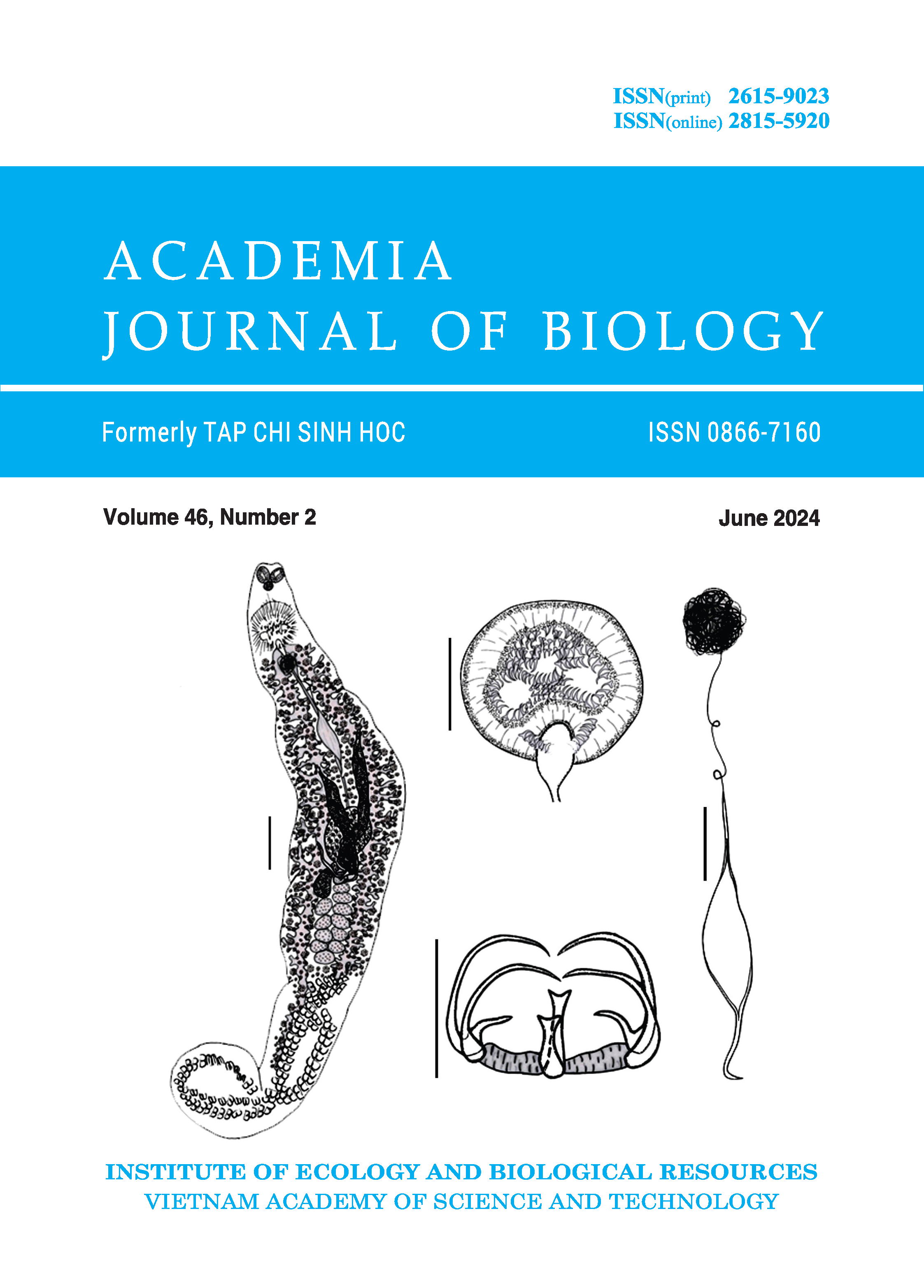Screening of novel conopeptide for mosquitocidal activity against lethal mosquitoes (Anopheles stephensi, Aedes aegypti)
Author affiliations
DOI:
https://doi.org/10.15625/2615-9023/20070Keywords:
Conus, mosquitocidal activity, venom, cone snails.Abstract
Mosquitoes are carriers of various diseases that result in millions of human deaths annually. However, the use of chemical mosquitocides has led to significant concerns, such as adverse effects on the environment, human health, and insecticide resistance. As a result, there is a pressing need for eco-friendly alternatives. This study aimed to identify potential mosquitocidal conopeptides from cone snail venoms targeting two lethal mosquito species, Anopheles stephensi and Aedes aegypti. Eleven Conus species were collected from Nha Trang Bay and their crude venoms were dissected and collected. Through cell survival and toxicity assays on mosquito larvae, five crude venoms were identified to have inhibitory effects. Further investigations involved fractionating these five crude venoms and testing them for cell cytotoxic activity were conducted. Four fractions from Conus bandanus venom, named CB37, CB39, CB41, and CB43, showed significant cytotoxic activity against cell survival. Other fractions from different Conus venoms also exhibited some cytotoxic activity at high concentrations but were not prioritised for further investigation. Toxicity experiments on adult mosquitoes revealed that the CB41 fraction had the most potential, with an IC50 of 30 μM. Additionally, this CB41 compound is a peptide in nature and was found to have a native mass of 3332.1 Da and three disulphide bridges. These results could deduce this long-chain peptide possessing a compact structure. To our knowledge, the conopeptide CB41 is reported first time to have mosquitocidal activity.
Downloads
Metrics
References
Fan C. X., Chen X. K., Zhang C., Wang L. X., Duan K. L., He L. L., Cao Y., Liu S. Y., Zhong M. N., Ulens C., Tytgat J., Chen J. S., Chi C. W., and Zhou Z., 2003. A novel conotoxin from conus betulinus, κ-BtX, unique in cysteine pattern and in function as a specific BK channel modulator. J. Biol. Chem., 278(15): 12624–12633.
Francis S. A., Taylor-Wells J., Gross A. D., and Bloomquist J. R., 2016. Toxicity and physiological actions of carbonic anhydrase inhibitors to Aedes aegypti and Drosophila melanogaster. Insects, 8(1): 2.
Gao B., Peng C., Lin B., Chen Q., Zhang J., and Shi Q., 2017. Screening and validation of highly-efficient insecticidal conotoxins from a transcriptome-based dataset of Chinese tubular cone snail. Toxins, 9(7): 214.
Kaur R., Choudhary D., Bali S., Bandral S. S., Singh V., Ahmad M. A., Rani N., Singh T. G., and Chandrasekaran B., 2024. Pesticides: An alarming detrimental to health and environment. Science of the Total Environment, 915: 170113.
Kumar M., Yadav A. N., Saxena R., Paul D., and Tomar R. S., 2009. Biodiversity of pesticides degrading microbial communities and their environmental impact. Biocatal. Agric. Biotechnol., 31.
Leng P., Zhang Z., Pan G., and Zhao M., 2011. Applications and development trends in biopesticides. African J. Biotechnol., 10(86): 19864–19873.
Lewis R. J., Dutertre S., Vetter I., and Christie M. J., 2012. Conus venom peptide pharmacology. Pharmacological Reviews, 64(2): 259–298.
Nguyen Ngoc Thach, 2005. Shells of Vietnam. ConchBooks. 338 pp.
Olivera B. M., and Teichert R. W., 2007. Diversity of the Neurotoxic Conus Peptides: A Model for Concerted Pharmacological Discovery. Mol. Interv, 7(5).
Rigo F. K., Dalmolin G. D., Trevisan G., Tonello R., Silva M. A., Rossato M. F., Klafke J. Z., Cordeiro M. D. N., Castro Junior C. J., Montijo D., Gomez M. V., and Ferreira J., 2013. Effect of ω-conotoxin MVIIA and Phα1β on paclitaxel-induced acute and chronic pain. Pharmacol. Biochem. Behav., 114: 16–22.
Schwartz E. F., Mourão C. B., Moreira K. G., Camargos T. S., and Mortari M. R., 2012. Arthropod venoms: a vast arsenal of insecticidal neuropeptides. Peptide science, 98(4): 385–405. doi: 10.1002/bip.22100
Wijngaarden R. P. V., Brock T. C., and Brink P. J. V. D., 2005. Threshold levels for effects of insecticides in freshwater ecosystems: a review. Ecotoxicology, 14: 355–380.
Wermeling D. P., 2005. Ziconotide, an intrathecally administered N‐type calcium channel antagonist for the treatment of chronic pain. Pharmacotherapy: The Journal of Human Pharmacology and Drug Therapy, 25(8): 1084–1094.
Windley M. J., Herzig V., Dziemborowicz S. A., Hardy M. C., King G. F., and Nicholson G. M., 2012. Spider-venom peptides as bioinsecticides. Toxins, 4(3): 191–227.
WHO (World Health Organization), 2005. Guidelines for laboratory and field testing of mosquito larvicides. Geneva : World Health Organization, Geneva.
WHO (World Health Organization), 2016. Mosquito-borne diseases. World Health Organization.
WHO (World Health Organization), 2023. Update on the Dengue situation in the Western Pacific Region. World Health Organization.
Yu R., Kaas Q., and Craik D. J., 2012. Delineation of the unbinding pathway of α-conotoxin ImI from the α7 nicotinic acetylcholine receptor. J. Phys. Chem. B, 116(21): 6097–6105.
Downloads
Published
How to Cite
Issue
Section
License
Copyright (c) 2024 Nguyen Bao, Phan Thi Khanh Vinh, Nguyen Van Suu, Jean-Pière LE CAER

This work is licensed under a Creative Commons Attribution-ShareAlike 4.0 International License.





